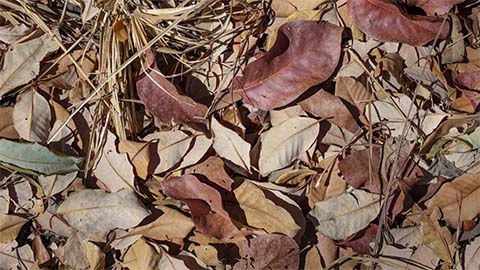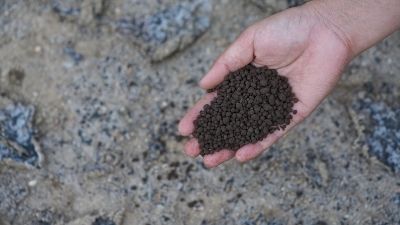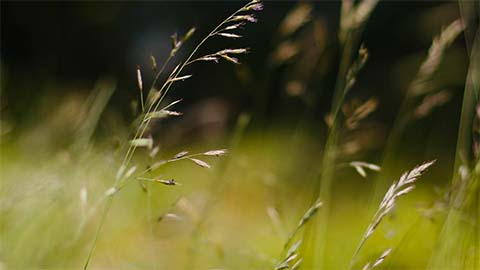Selecting and Using Inorganic Fertilizers
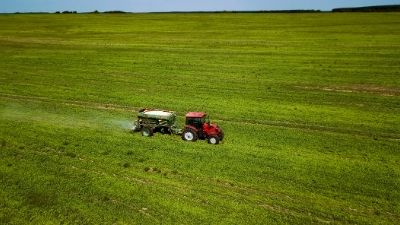
Introduction
Homeowners recognize the need for timely fertilizer applications to enhance plant growth in landscapes and gardens. However, the number of different products on the market can be overwhelming. Nursery and garden supply stores commonly stock a dozen or more fertilizer products, each with a different concentration of plant nutrients. One fertilizer may be better for a specific situation than another, and different fertilizers need to be applied at different rates to supply the correct amount of plant nutrients.
Improper fertilizer application can contribute to surface and ground water pollution, may induce a plant nutrient deficiency or toxicity, or cause salt burn. Properly used, inorganic fertilizers are safe for plants and the environment. The purpose of this guide is to provide general selection and use information for inorganic fertilizers. See the related guide, Selecting and Using Organic Fertilizers, for similar information on organic products.
Determining Nutrient Needs
Nutrient needs vary widely depending on soil conditions, previous fertilizer and organic matter additions, and the type of plants grown. The best way to determine which nutrients are needed and in what amounts is to test the soil. A soil test (cost: $10.00 to $40.00 per sample) is recommended every two to three years for landscapes and gardens. Sample soils more frequently if you have problems. See your County Extension Agent for instructions on how to collect soil samples and where to send them for analysis.
A soil test report will be accompanied by interpretations and nutrient recommendations for your specific conditions. Nitrogen is the most common nutrient needed in home landscapes and gardens. Table 1 summarizes nitrogen recommendations for a variety of plants. Refer to your soil test report to determine if nitrogen is needed. Ornamentals such as trees and shrubs, as well as turf, will grow at slower rates if less nitrogen is used than the recommendations listed in Table 1. Slower growth rates may be desirable depending on the goal of the landscaper and the intensity of management. Vegetable nitrogen requirements are designed to produce optimum yields in a garden setting.
For soil testing, visit USU Analytics Lab, or contact (435) 797-2217.
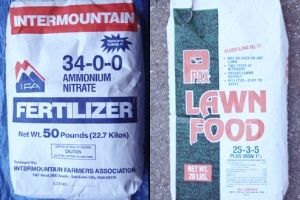
Selecting a Fertilizer
The numbers on a fertilizer label refer to the concentration (percent) of three major nutrients in the material: nitrogen (or N), phosphate (or P2O5), and potash (or K2O). For example, a 25-3-5 fertilizer (Figure 2) contains 25% nitrogen, 3% phosphate (P2O5), and 5%
potash (K2O). This means that 4 pounds of 25-3-5 would supply 1 pound of nitrogen (4 x 0.25), 0.12 pound of phosphate (4 x 0.03), and 0.2 pound of potash (4 x 0.05). Other common fertilizer formulations are listed in Table 2. Fertilizer labels have been standardized so that the concentrations of nitrogen, phosphate, and potash always appear in the same order on the front of the package. Other components such as iron, zinc, or sulfur may be specified elsewhere on the label.
The variety of fertilizers on the market means the homeowner can find a product to meet any need. Minimize the application of nutrients listed as adequate, high, or excessive on a soil test report. Further application of fertilizers containing these nutrients may create an imbalance and reduce plant growth. If a soil test report recommends only nitrogen, use ammonium nitrate (34-0-0), ammonium sulfate (21-0-0), or another fertilizer high in nitrogen (Table 2). If nitrogen and phosphorus are recommended, use a fertilizer such as 30-10-0. Assume for example that a soil test report recommends 2 pounds (lbs) of nitrogen and 1 pound of phosphate per 1000 square feet. Using the 20-27-5 formulation (Table 2) would result in the over-application of phosphate, while the 30-10-0 formulation (Table 2) would slightly under-apply phosphate. The gardener may decide to apply 20-27-5 for one year and build up soil phosphorus levels, then retest the soil and switch to a nitrogen-only fertilizer in subsequent years. Alternatively 34-0-0 or 21-0-0 could be applied to meet the nitrogen requirement and 0-45-0 to meet the phosphorus requirement.
Table 1. Annual nitrogen recommendations for landscape and gardens plants.
| Plants | General requirements | Recommendation |
|---|---|---|
| Ornamentals |
Low: xeriscapes, natural areas Intermediate: standard landscapes High: flower beds, new landscapes |
0 to 1 pound of nitrogen/1000 sq ft 1 to 2 pounds of nitrogen/1000 sq ft 2 to 4 pounds of nitrogen/1000 sq ft |
| Turf* |
Low maintenance Intermediate maintenance High maintenance |
0 to 1 pound of nitrogen/1000 sq ft 2 to 3 pounds of nitrogen/1000 sq ft 4 to 6 pounds of nitrogen/1000 sq ft |
| Vegetables** |
Low: peas, beans Intermediate: asparagus, beet, carrot, melon, cauliflower, broccoli, brussels sprout, celery, pepper, tomato, lettuce, radish, spinach, turnip, squash, pumpkins High: onion, sweet corn, potato |
1 to 2 pounds of nitrogen/1000 sq ft 2 to 3 pounds of nitrogen/1000 sq ft 4 to 6 pounds of nitrogen/1000 sq ft |
*Split the total amount of nitrogen into 2 or more separate applications made over the growing season. To prevent burning do not apply more than 1 ½ pounds of nitrogen/1000 sq feet in a single application.
**For high nitrogen requirement vegetables, apply the intermediate recommendation before planting, then broadcast or band additional nitrogen after plants are well established (see text under fertilizer application methods).
Table 2. Common fertilizers found in Utah landscape, garden, and farm supply stores
| Name | Fertilizer label (Nitrogen-Phosphate-Potash) | |
|---|---|---|
| Single nutrient fertilizers |
Ammonium nitrate Ammonium sulfate Urea Triple superphosphate Potassium chloride |
34-0-0 21-0-0 46-0-0 0-45-0 0-0-60 |
| Multi-nutrient fertilizers |
Ammonium phosphate Turf fertilizer Lawn fertilizer Lawn food Turf builder Starter fertilizer Winterizer Balanced fertilizer |
11-52-0 or 18-46-0 30-10-0 29-3-4 25-3-5 32-3-2 20-27-5 22-4-14 16-16-16 |
| Special purpose fertilizers |
Vegetable food Rose food Acidic fertilizer |
12-12-12 20-10-5 30-10-10 |
Fertilizers vary considerably in price. The cost of different fertilizers should be compared on a per pound of nutrient basis. Cost per pound depends on the package price, weight, and nutrient concentration in the fertilizer. For example, if a 36 lb bag of 29-3-4 cost $15.88 and a 20 lb bag of 21-0-0 cost $2.99, which is the least expensive source of nitrogen? The cost per pound of nitrogen is $1.52 for the 29-3-4 and $0.71 for the 21-0-0. More expensive fertilizers often contain pesticides for weed or insect control, and may have added micronutrients or slow release characteristics. Compare prices among products and purchase fertilizers with special additives
only if they are needed. Most fertilizers containing herbicides are meant to be used on turf and will stress ornamental trees and shrubs, and kill most vegetables and flowers. Read and follow label instructions carefully when using fertilizers containing pesticides.
Fertilizer Rate Calculations
Nutrient recommendations for gardens and landscapes are expressed in pounds per 1000 square feet (Figure 1; Table 1). Calculate the amount of fertilizer needed by using the soil test nutrient recommendation, the concentration of nutrients in the fertilizer selected, and the size of the area fertilized. Garden and landscape areas are usually different than 1000 square feet. Estimate the size of the area to be fertilized by pacing or using a measuring tape to determine the length and width. Multiply the length by the width to calculate area. A simple formula used to calculate the amount of fertilizer required to meet a nutrient recommendation is:

Where X is the nutrient recommendation from a soil test report in pounds/1000 sq ft, Y is the percent of the nutrient in the fertilizer divided by 100, and Z is the square footage of the area fertilized. Garden and landscape areas are usually different than 1000 square feet. Estimate the size of the area to be fertilized by pacing or using a measuring tape to determine length and width. Multiply length by width to calculate area.
Example: A gardener is using blood meal (12-2-1; Table 2) to supply 2 pounds of nitrogen per 1000 square feet. The garden area is 1400 square feet. How much 12-2-1 fertilizer is required for this situation? Answer: In the above equation, X is 2 pounds, Y is 0.12 (12% divided by 100), and Z is 1400 square feet. Entering these numbers into the equation gives an answer of 23 pounds of 12-2-1 fertilizer for the garden. A helpful conversion for fertilizers is 1 pint volume equals approximately 1 pound of dry fertilizer.
The amount of fertilizer calculated in the above example may not seem like much when spread over a large area (see Figure 3). Consider, however, that a high yielding crop of silage corn may require 200 pounds of nitrogen per acre, which is approximately 4 ½ pounds of nitrogen per 1000 square feet (similar to the sweet corn nitrogen recommendation in Table 1). To facilitate ease of use and keep transportation costs low, inorganic fertilizers are manufactured as highly concentrated sources of nutrients. This means that applicators need to accurately calculate and apply fertilizers at the appropriate rates to supply the correct amount of plant nutrients without damaging plants or causing adverse environmental effects.
Fertilizer Application Methods
Fertilizers may be broadcast on the surface then tilled or watered into soil, or banded on or beneath the soil surface (Figure 3) . Broadcasting is efficient and often the method of choice in areas with perennial plants. Two main types of broadcast applicators are available: the rotary spreader and the drop spreader (Figure 4). Drop spreaders can uniformly apply a wide range of fertilizer rates; however, the path of spread is limited to the width of the unit (normally 18 inches to 3 feet for low cost units). Rotary spreaders broadcast fertilizer in a 10 to 20 foot wide path with less uniformity and rate control than drop spreaders. Either spreader type will work well for homeowners if properly calibrated and operated.
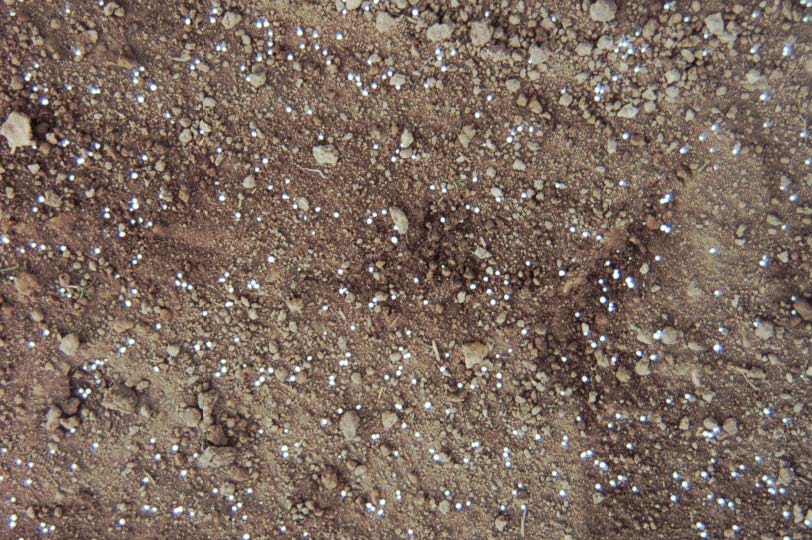
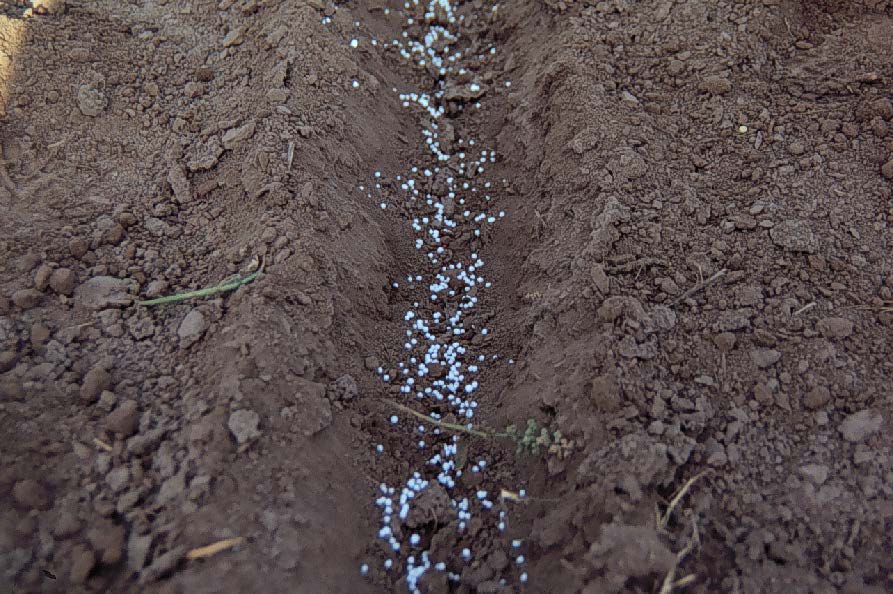
the soil surface (left) or banded in rows with 24 inch spacing (right).
Spreaders are adjustable for different fertilizers and rates of application. Spreader manufacturers often list calibration settings for specific fertilizers. Likewise, many fertilizer manufacturers list settings for specific spreader models. Since manufacturers cannot list calibration settings for all situations, it is good practice to calibrate the unit for your use. Set the spreader to the closest manufacturer’s setting for the rate and type of fertilizer you will apply. Place 2 pints of kitty litter in the unit and spread in a continuous straight path. Note the width of the spread path and the distance traveled to broadcast the litter. Calculate the rate of application (assuming 1 pint of litter equals 1 pound of fertilizer) and compare this to the rate needed. For example, if a rotary spreader broadcasts a 10 foot wide path and you traveled 40 feet to empty 2 pints of litter from the hopper, the rate of application would be equivalent to 2 pounds per 400 square feet (10 ft x 40 ft), or 5 lbs/1000 square feet. If a different rate is needed the spreader setting should be changed and the unit calibrated again. Once a spreader is calibrated for a specific rate keep a record of the setting for future use. .
Avoid streaking caused by fertilizer skips and overlap by applying one-half of the calculated rate while traveling in one direction and the remaining one-half while traveling in a perpendicular direction. This method of application is especially useful for turf fertilization where streaking is common.
Banding (Figure 3) is a convenient way to make in-season fertilizer applications to high nitrogen requiring vegetables like corn. To band fertilizer first calculate the amount needed for an area as if you were going to broadcast the material. Divide this amount by the number of plant rows in the area to determine the amount of fertilizer to apply in each row. Make narrow furrows 8 to 10 inches away from the base of the plants, 2 to 3 inches deep. Distribute the fertilizer evenly in the furrow and cover with soil.
Foliar applications can be made with any water-soluble product and are commonly used for applying small amounts of micronutrients such as iron and zinc. There is potential for foliar burning with sprays so follow product label instructions carefully. A 2% fertilizer solution by weight is generally safe for use as a foliar spray. Mix a 2% solution by adding 0.15 lb (approximately 1.25 fluid ounces or 2 ½ tablespoons) fertilizer per gallon of water. Apply foliar sprays early in the morning or late in the evening to minimize leaf burning. Thoroughly cover foliage with the spray solution.
Published December 2011
Utah State University Extension
Peer-reviewed fact sheet
Download PDF
Authors
Rich Koenig, Extension Soil Specialist; Larry Rupp, Extension Horticulturist
Related Research


